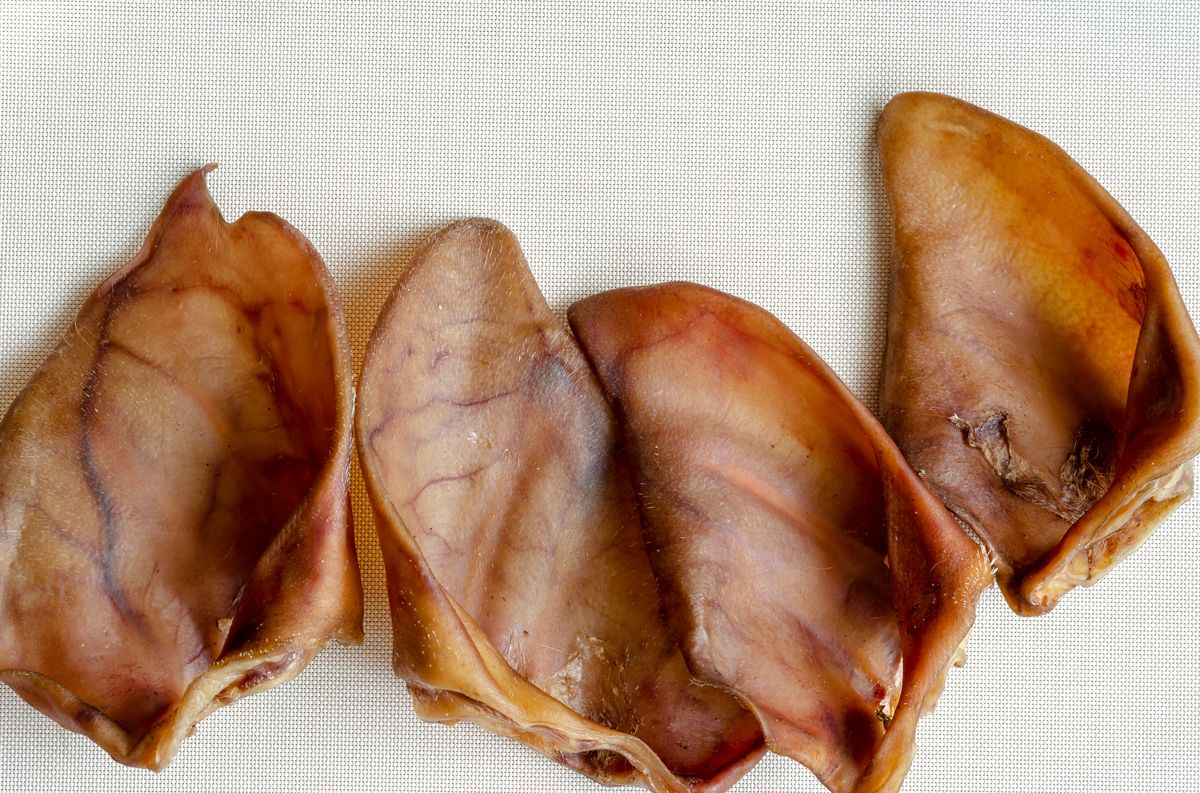Pig ears, an often overlooked part of the animal, offer a unique and flavorful culinary experience. Whether you're a fan of exotic cuisine or curious about the nutritional benefits, this article will delve deep into the world of pig ears. In this comprehensive guide, we'll explore the anatomy of pig ears, their cultural significance, health benefits, and much more.

The Anatomy of Pig Ears
Pig ears, a culinary curiosity for some, are a unique part of the pig's anatomy. Understanding their structure and composition sheds light on why they offer such a distinctive culinary experience.
Structure and Composition
Pig ears are primarily composed of cartilage, skin, and a moderate amount of fat. It's the cartilage that gives pig ears their characteristic chewy texture. This cartilage is a dense, connective tissue that provides structural support to the ear.
The skin on pig ears is quite thin and delicate compared to other parts of the pig's body. This thinness makes it particularly suitable for crisping up during cooking, creating a satisfying contrast in texture.
The modest amount of fat found in pig ears contributes to their flavor and juiciness when cooked. The fat can render and become crispy when exposed to high heat, adding a delightful richness to dishes.
Understanding this anatomy is crucial for chefs and home cooks who wish to make the most of pig ears in their culinary creations. Proper preparation, which may include cleaning, blanching, or marinating, can enhance the texture and flavor of this unique ingredient.

Cultural Significance of Pig Ears
Across the globe, pig ears hold cultural significance that transcends their role as a mere culinary ingredient. Their presence in traditional dishes and celebrations speaks to their importance in various cultures.
Culinary Uses
Pig ears are featured in a wide array of international cuisines. In many Asian countries, they are a prized ingredient, often used in soups, stir-fries, or as a stand-alone snack. In China, "Pig Ear Salad" is a popular dish, showcasing thinly sliced pig ears dressed in a flavorful sauce.
In Mexico, "tacos de oreja" (ear tacos) are a delicacy that highlights the crispiness of pig ears when deep-fried and served in a tortilla with vibrant salsa. This dish demonstrates how pig ears can be transformed into a delightful street food.
Traditional Dishes
Beyond street food and appetizers, pig ears play a prominent role in traditional dishes. In Filipino cuisine, "sisig" features chopped and sautéed pig ears with spices and citrus, creating a savory and tangy dish that is a beloved part of the country's culinary heritage.
In southern states of the United States, particularly in soul food cuisine, pig ears have been used to flavor collard greens, imparting a distinctive smoky and meaty taste to the dish.
These examples illustrate how pig ears have not only found their way into the culinary landscape but also become cultural symbols of flavor and tradition.
Health Benefits of Consuming Pig Ears
Pig ears, beyond their culinary appeal, offer a surprising array of health benefits that make them a unique addition to your diet.
Protein and Collagen
Pig ears are a noteworthy source of protein, containing roughly 15-20 grams of protein per 100-gram serving. Protein is essential for the growth, repair, and maintenance of various bodily tissues, making it a fundamental component of a healthy diet.
What sets pig ears apart is their collagen content. Collagen, a protein found in skin and connective tissues, is abundant in pig ears due to their cartilaginous structure. Collagen is recognized for its role in promoting skin elasticity and joint health. Consuming collagen-rich foods like pig ears may contribute to healthier skin, hair, and joints.
Nutrient Profile
While pig ears are not a conventional superfood, they do provide essential nutrients. Pig ears contain vitamins and minerals such as riboflavin (vitamin B2), niacin (vitamin B3), and zinc. These nutrients play diverse roles in maintaining overall health, from aiding in metabolism to supporting the immune system.
It's important to note that while pig ears offer some nutritional benefits, they should be consumed in moderation as part of a balanced diet. As with any dog food, portion control and proper cooking methods are key to maximizing their advantages while minimizing potential drawbacks.
Common Culinary Preparations
Pig ears, with their intriguing texture and rich flavor, lend themselves to a variety of culinary preparations that cater to diverse tastes and preferences.
Cooking Methods
One of the most popular methods of preparing pig ears is deep-frying. Slicing them into thin strips and frying until crispy creates a delightful snack or topping for salads. The high heat transforms the skin into a crunchy, golden-brown delight, contrasting beautifully with the tender cartilage within.
Another common cooking method involves simmering or braising pig ears in flavorful broths or sauces. Slow cooking allows the cartilage to soften, resulting in a more tender and succulent texture. This method is often used in Asian cuisines, where pig ears are incorporated into soups and stews, infusing them with a rich umami flavor.
Popular Recipes
The versatility of pig ears extends to a myriad of dishes. In Chinese cuisine, "Hunan Smoked Pork Ears" showcase thinly sliced pig ears seasoned with spices and smoked to perfection. In Mexico, "Tostadas de Cuero" features pig ears marinated in a tangy salsa, creating a harmonious blend of textures and flavors.
In the southern United States, pig ears are used to flavor collard greens and beans, adding a unique smoky essence to these beloved dishes. The crispy pig ears' contrast complements the hearty greens and beans exceptionally well.
Are Pig Ears Safe to Eat?
Food Safety Concerns: We address common concerns related to consuming pig ears, including bacterial contamination and cooking safety.
Precautions: Tips on handling and cooking pig ears to ensure they are safe for consumption.

Pig Ears in Pet Products
Pig ears have transcended their role in human cuisine to become a popular component of pet products, particularly in the realm of dog treats and chews. This section explores the use of pig ears in pet-related offerings and the considerations that come with them.
Dog Treats and Chews
Pig ears have gained immense popularity as a treat and chew option for dogs. These treats are often available in pet stores and online, marketed as a flavorful and engaging option to satisfy a dog's chewing instincts.
Benefits
- Dental Health: Chewing pig ears can help promote dental health in dogs. The act of chewing can reduce plaque buildup and tartar on their teeth, potentially preventing dental issues.
- Mental Stimulation: Pig ears offer mental stimulation for dogs. Chewing can be a calming and stress-relieving activity, especially for dogs prone to separation anxiety.
- Protein Source: Pig ears are a source of protein for dogs, contributing to their overall dietary needs.
Risks
- Caloric Content: Pig ears are calorie-dense, so they should be given in moderation to avoid excessive weight gain.
- Digestive Sensitivity: Some dogs may have digestive sensitivities to pig ears, so it's essential to monitor your pet's reaction when introducing them.
- Bacterial Contamination: Like any meat product, pig ears can carry bacteria. Proper handling, storage, and hygiene are crucial to ensure dog safety.
Pet owners need to select high-quality pig ear products from reputable manufacturers. Reading labels and consulting with veterinarians can help ensure that the treats or chews are safe and suitable for your dog.
Sustainability and Ethical Considerations
The consumption of pig ears, like many animal-derived products, raises ethical and sustainability concerns. Understanding these issues is vital for making informed choices about their consumption.
Environmental Impact
The environmental impact of pig ear production extends to factors like land use, water consumption, and greenhouse gas emissions associated with pig farming. Large-scale pig farming can strain natural resources and contribute to deforestation, soil degradation, and water pollution.
Animal Welfare
Ethical concerns surrounding pig ear consumption relate to the treatment of pigs in the farming industry. The conditions in which pigs are raised and slaughtered can vary significantly, and some practices may raise ethical red flags.
Responsible Sourcing
Consumers concerned about sustainability and animal welfare can seek out pig ear products from suppliers committed to responsible sourcing. This may involve choosing products that come from farms or suppliers adhering to ethical and sustainable practices, such as free-range or pasture-raised pig farming.
Additionally, supporting initiatives that promote animal welfare and sustainability within the livestock industry can contribute to positive change.
Pig Ears Around the World
Pig ears, though considered unconventional in many Western diets, enjoy a global presence and are incorporated into various culinary traditions worldwide. This section explores how different cultures across the globe prepare and savor pig ears.
International Variations
Asia
In many Asian countries, pig ears are a delicacy. China, in particular, has a rich tradition of using pig ears in its cuisine. "Cold Pig Ear Salad" is a popular Chinese dish, featuring thinly sliced pig ears seasoned with a flavorful blend of soy sauce, vinegar, and spices. These tender yet crunchy slices create a harmonious balance of textures and flavors.
In Japan, "Kaki no Tane" snacks sometimes include pig ear components. These rice crackers often feature a crispy, pig ear-inspired texture.
Mexico
Mexico's culinary landscape boasts "tacos de oreja" (ear tacos), where pig ears are deep-fried to perfection and served in tortillas with vibrant salsas. This Mexican street food showcases the irresistible crunchiness of pig ears, proving that they can be a star ingredient in beloved dishes.
Philippines
In Filipino cuisine, "sisig" stands out as a beloved dish made from chopped and sautéed pig ears. Spiced with an array of seasonings and typically served sizzling on a hot plate, sisig embodies the bold flavors and textures that characterize Filipino food.
Cultural Perspectives
Beyond their culinary uses, pig ears hold cultural significance in various societies. They often symbolize resourcefulness and a commitment to utilizing all parts of an animal, reflecting a respect for nature's offerings.
In some cultures, pig ears have been used in traditional healing practices, attributed with therapeutic properties. While these perspectives vary, they underscore the multi-dimensional role of pig ears in different cultural contexts.

Pig Ears in Popular Culture
Pig ears have transcended the realm of cuisine to make appearances in popular culture, symbolizing various themes and ideas. This section explores their unexpected presence in media, entertainment, and symbolism.
Media and Entertainment
Pig ears have made intriguing cameos in movies, TV shows, and literature. These appearances often carry symbolic or thematic significance. In "The Silence of the Lambs," a chilling thriller, pig ears are memorably featured as part of a gruesome crime scene, adding an element of horror to the narrative.
In literature, authors have used pig ears as metaphors or symbols. For instance, in George Orwell's "Animal Farm," the pigs' consumption of human luxuries, including alcohol and delicacies like pig ears, symbolizes their corruption and betrayal of the farm's ideals.
Symbolism
Pig ears have taken on symbolic meanings in various cultural contexts. They can represent notions of abundance, resourcefulness, and adaptability. In some cases, pig ears have been seen as a reminder of the importance of utilizing every part of an animal, aligning with principles of sustainability and respect for nature.
Their symbolic significance extends to art and fashion, where pig ear motifs may be employed to convey unconventional ideas or challenge societal norms.
Are There Alternatives to Pig Ears?
When it comes to finding alternatives to pig ears, you're not limited in choices. Pig ears are popular treats for dogs due to their chewy texture and savory flavor, but they're not the only option out there.
Similar Edible Parts
Firstly, let's delve into edible animal parts that are comparable to pig ears. Cow ears, for instance, offer a similar chewing experience and are often lower in fat. Chicken feet are another alternative; they provide the requisite crunch and are packed with healthy nutrients like glucosamine. Lamb ears and turkey necks are also gaining popularity for their rich flavors and varied textures, presenting your pet with a wholesome and satisfying chewing experience. Each of these options can be a delightful and nutritious substitute, offering not just taste but also beneficial nutrients.
Vegetarian Options
For those looking to explore plant-based alternatives, there are plenty of innovative solutions available. Sweet potato chews are a great example, providing a chewy texture that dogs love, along with a host of essential nutrients like beta-carotene. Brown rice cakes, broken into appropriate sizes, can offer a crunchy, satisfying snack that's easy on the digestive system. Coconut husks are another interesting option; they're fibrous and tough, providing a long-lasting chew that's entirely plant-based. Various brands now offer vegan dog chews made from ingredients like rice protein and sweet potatoes, explicitly designed to mimic the texture and taste of traditional animal-based treats.
Whether you're looking for something similar to pig ears or searching for a completely different, vegetarian alternative, there's a plethora of options to suit every preference and dietary need. With a little research and perhaps some taste-testing, you can find the perfect alternative that both you and your pet will love.
Cooking Tips and Recommendations
When it comes to cooking pig ears, there are some key considerations to keep in mind to elevate your culinary creation to the next level.
Flavor Pairings
Pig ears are remarkably versatile when it comes to flavor pairings. Due to their rich, fatty profile, they complement well with tangy, acidic elements like apple cider vinegar or citrus fruits. Consider using spices like paprika, cayenne, or garlic to add a kick that cuts through the fat. Fresh herbs like thyme, rosemary, and cilantro can add a fragrant touch, enhancing the dish's overall flavor. These combinations work synergistically to balance and accentuate the unique taste of pig ears, making each bite a memorable experience.
Texture and Consistency
Achieving the right texture is crucial for enjoying pig ears to the fullest. If you're aiming for a crispy finish, consider boiling the ears first to tenderize them, then frying until golden. For a softer, more gelatinous texture, slow-cooking or braising is the way to go. The key here is to be patient; pig ears benefit from slow, low-heat cooking methods to break down the collagen and render the fat. Monitoring the cooking time and temperature will help you achieve the desired texture, making your pig ear dish not just tasty but texturally appealing as well.
By paying attention to flavor pairings and mastering the art of achieving the right texture, you can transform pig ears from a lesser-known cut into a gourmet delicacy.
Conclusion
Pig ears are more than just an overlooked cut of meat; they are a culinary gem awaiting discovery. With their unique, gelatinous texture, they offer versatility in cooking, appearing in everything from stir-fries to appetizers across various global cuisines.
Nutritionally, they're a source of collagen, beneficial for skin and joint health, although they should be consumed in moderation due to their fat content. Incorporating pig ears also aligns with the ethical approach of nose-to-tail eating, which aims to reduce waste by utilizing the entire animal.
In short, if you're keen on expanding your culinary repertoire, pig ears provide a unique blend of flavors, textures, and nutritional benefits worthy of exploration.

FAQs about Pig Ears
1. Are pig ears safe for human consumption?
Yes, pig ears are safe for human consumption when prepared and cooked properly.
2. How should I store pig ears to maintain freshness?
To maintain freshness, store pig ears in the refrigerator in an airtight container or vacuum-sealed bag.
3. Can I feed pig ears to my dog as a treat?
Yes, many happy dog owners give pig ears to their pets as a chewy and enjoyable treat. However, consult your veterinarian for specific recommendations based on your dog's health.
4. What are some international dishes featuring pig ears?
International dishes featuring pig ears include Mexican tacos de oreja, Chinese cold pig ear salad, and Filipino sisig.
5. Are there any ethical concerns regarding pig ear consumption?
Yes, there are ethical concerns related to the sourcing and treatment of animals for food, including pig ears. It's essential to consider these ethical aspects when choosing to consume pig ears and support responsible sourcing practices.






